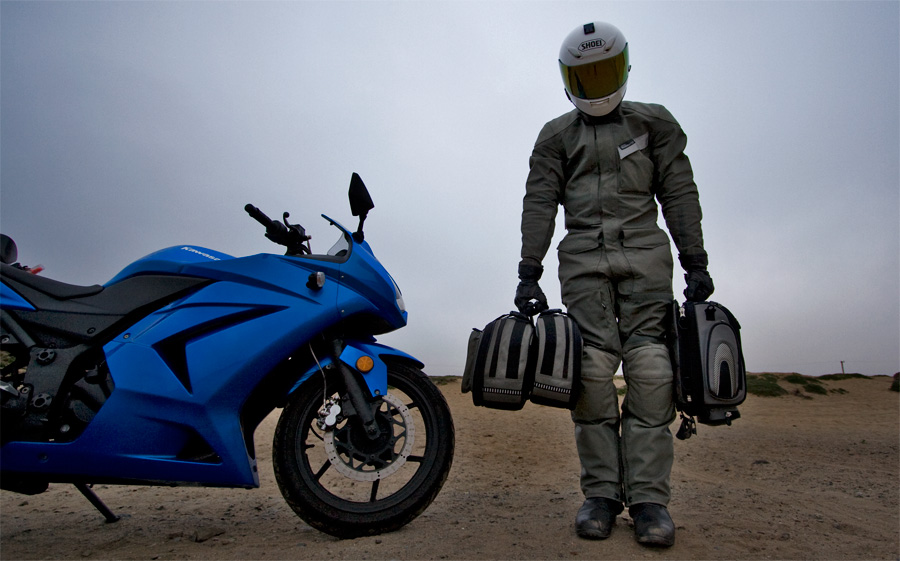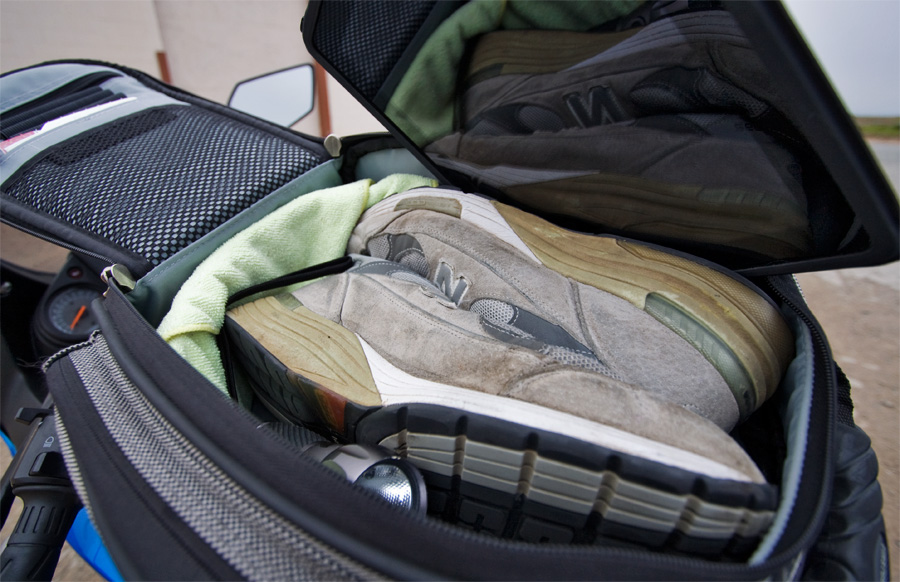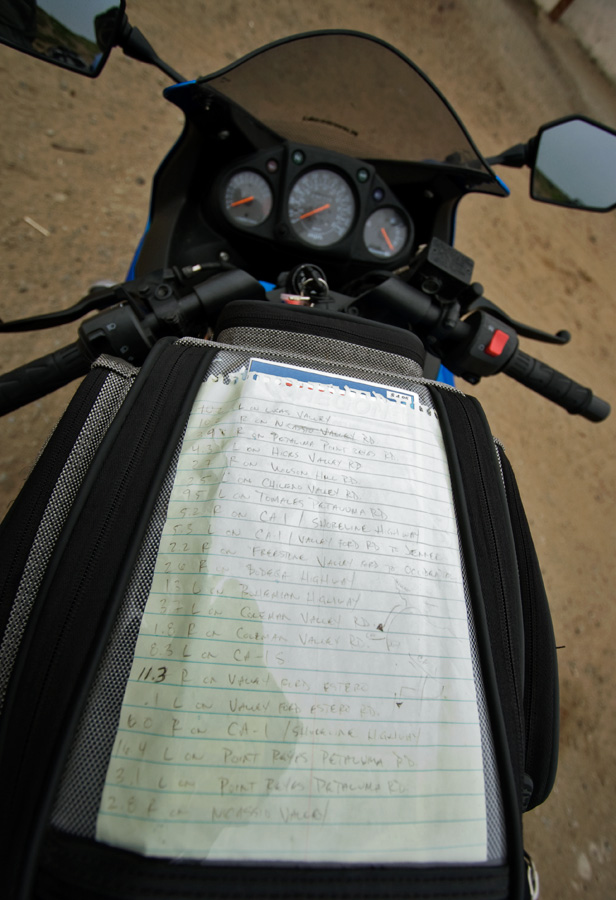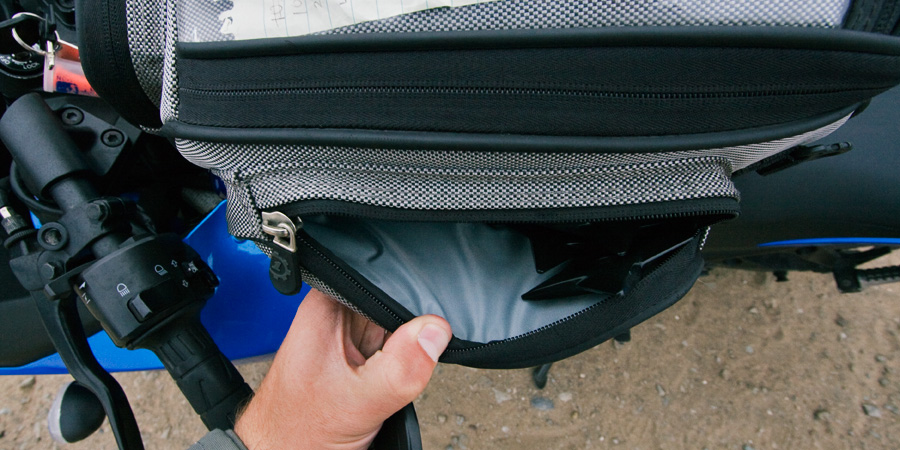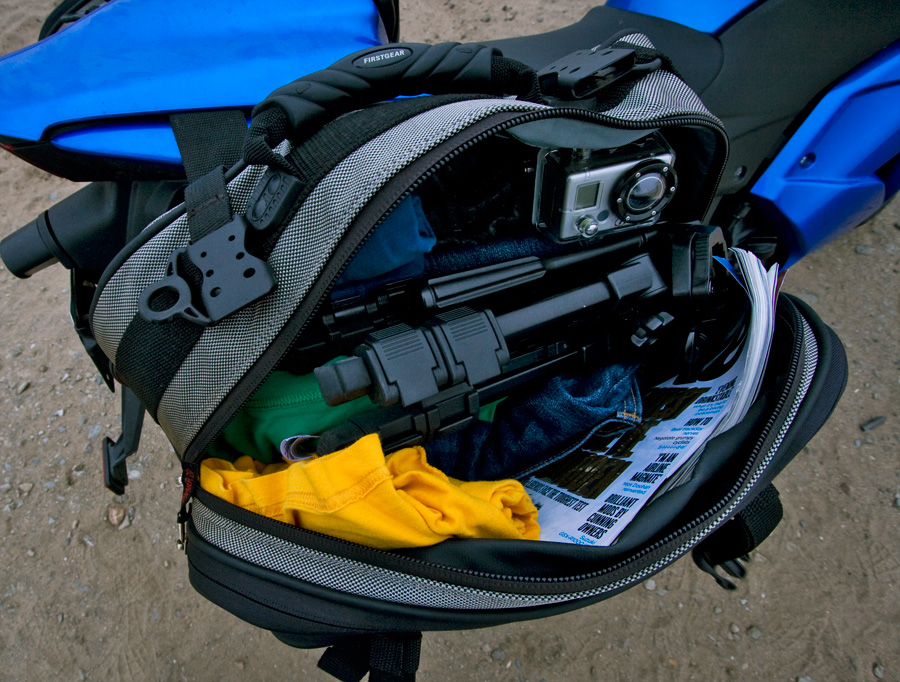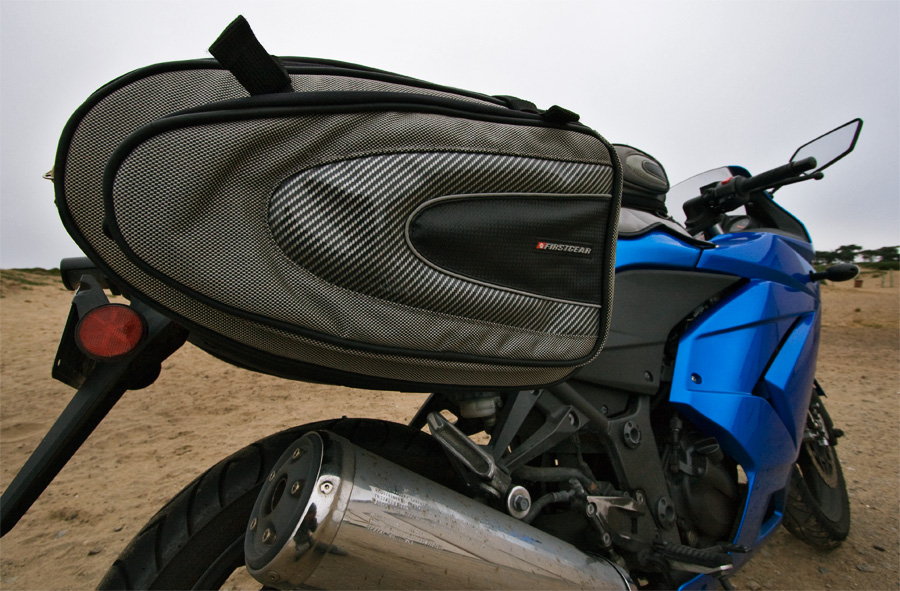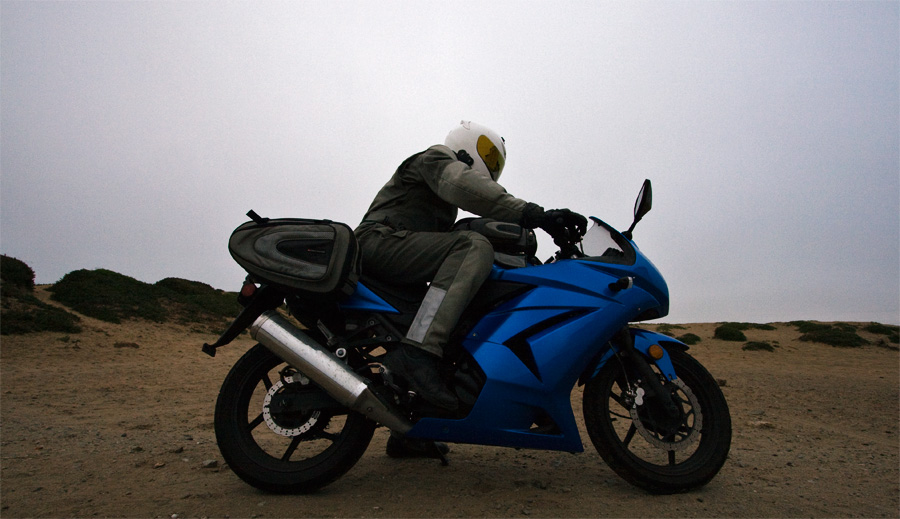I’d love to argue that a motorcycle is a perfectly suitable replacement for four wheels. Sadly, the dream deflates the first time groceries or overnight travel is involved. I’ve ridden a bicycle two miles home with three extra-large pizzas balanced in one palm, but there’s too much involved with a motorcycle to repeat those shenanigans. The most I’ve dared is riding the 250 home with a pair of bicycle tires slung over my neck and shoulder.
The budding motorcycle enthusiast will, at some early point in his riding career, decide that it’d be nice to transport more than a fart’s mass stuffed under the passenger seat of his bike. And that calls for luggage, which is rarely cool. Steve McQueen certainly never bothered.
The balance between biker cool and nerd practical is familiar to most riders. It’s a balance made when choosing a motorcycle, when picking out protective gear, and when plastering one’s bike with other people’s logos (if cool is the opposite of practical, “Monster” logos are the most practical). Some riders forgo practicality altogether, but they don’t read blogs so I’m not concerned with their concerns.
I wanted luggage for the Ninja 250 but didn’t want to risk the sleek cool of the 2008 fairings. I needed capacity to lug a week’s worth of t-shirts a couple thousand miles without conjuring thoughts of pocket protectors and duct-taped glasses. I bought First Gear’s Silverstone motorcycle bags. And after thousands of miles of use, they still please me.
Tank Bag II
I bought the tank bag first, mostly on a whim because I was at the local moto shop and had money burning a hole in my leathers. After swiping my card at the register, I had a flash of panic realizing that I didn’t drive my car and I’d have to transport the new, largish purchase by motorcycle.
It was a dumb thought. But in retrospect it highlighted a common anxiety for riders without luggage, a nagging hesitation to do simple things like stop by a farmer’s market on the way home.
It was a dumb thought because the Silverstone tank bag fits to the Ninja 250 in all of about five seconds of effort. There are optional fiddly straps for securing the bag, but the inbuilt magnets attach perfectly to the 250’s metal gas tank. I’ve never once used those straps (they’re stashed in the closet); the magnets hold firm, and I’ve tested them for thousands of miles at a time.
The magnetic mounting does make it easy for a thief to walk away with the bag and its contents–for a more secure fitting, the straps could be useful, though I suspect most thieves aren’t bright enough to realize the bag’s on magnets anyway. The upside to easy removal of the tank bag is that it’s actually completely necessary. To get access to the gas filler cap, the bag must be pried off the tank and set aside. Don’t leave it behind.
The Silverstone tank bag is about as big as I’d want on the 250. It’s larger than some bags, smaller than others but swallows a decent pile of junk. I’ve used it to transport a nighttime helmet visor, visor cleaning kit, and a host of equipment for (and including) my Canon Rebel DSLR. The bag’s shape makes it easy to use every inch of storage space. A zip around the base of the bag goes loose to allow for an extra inch of capacity–too little difference to change the bag’s usefulness, but just enough that it’ll comfortably fit whatever got over-stuffed into the zipped-up case. Imagine letting loose the top pants button after a gluttonous meal, not trying to make room for more, just relieving a bit of pressure. A couple of side pockets hold separate smaller items. Useful for organizing and maintaining quick access to commonly-used stuff like lip balm, flashlights and throwing stars.
The see-through map pocket on the top of the bag is a common feature among tank bags, and for good reason. Don’t buy a tank bag without one. The clear plastic swath is fairly large on the Silverstone, though the narrowness of the pocket opening requires special vertical folding of maps. A bulleted list of navigation directions slides in perfectly. The Silverstone also includes a second map pocket sewn under the bag, into the magnetic mounting base. The bag can separate from the mounting base with a zip, leaving behind a wafer-thin map pocket. I’ve never used the feature. If I’m going to bother fitting the mounting base, why wouldn’t I also bring the bag?
Unzipping the main bag from the mounting base is the first step in converting the Silverstone tank bag into a girly-quaint backpack. Attached shoulder straps fold out from under the bag to complete the transformation. Not a great backpack, mind, but it beats extended off-bike time with a heavy tank bag in your hands.
Carrying the Silverstone tank bag by hand is a bit awkward using its standard grab handle and while holding other clobber, like a helmet and a set of keys. The magnetic flaps fold under the bag but the magnets don’t get close enough to positively attract each other–it’d be hugely helpful if the magnets held the flappy mounting base tight against the bottom of the bag, but it’s sadly not the case. The flaps hold, but only barely.
Like the rest of First Gear’s Silverstone line, the tank bag is semi-stiff in construction. The bag holds its shape even when empty, so it never looks like a sad, soggy pile of fabric. There’s no guaranteed waterproofness, but the firm shell has kept contents dry in the few rainstorms it’s suffered. Sitting directly behind the Ninja’s windshield certainly helps.
Saddle Bags
Still flirting with the line between form and function, I opted for saddle bags that match the Silverstone tank bag. Because matching is important. Naturally, this desire for symmetrical appearance resulted in a pair of Silverstone saddle bags draped o’er the rear of my bike.
Like the tank bag, the Silverstone saddle bags sit somewhere in the middle of moto luggage sizing. They’re not uselessly small, but they’re also not made to supply your ’round-the-world trip with fresh skivvies every day. There’s generous packing volume from the sleek bags, though the quasi-wedged shape does make it difficult to fill every square inch. Malleable items like sweatpants and cooperative small pets pack easily, but solid kit like shoes and a camera tripod take more space than they ought. Like the tank bag, each saddle bag has an optional zip that lets the bags expand outward. Here, though, the extra space is more substantial.
Fitting the Silverstone saddle bags isn’t quite as effortless as slapping down the tank bag’s magnetic base. A pair of straps that connect either bag to the other lay flat across the back of the Ninja with the rear seat (or cowl) removed. Lock the seat back onto the bike and the straps are effectively held in place. I experimented with additional support by employing the liberal use of included bungees, but the effort isn’t necessary. I’ve since run the saddle bags without bungees tying ’em down and had zero issues with the bags holding in place.
The bad news is that, like the tank bag, these things aren’t waterproof. Worse, the saddle bags don’t get the rain blast protection of the Ninja’s screen and so suffer the brunt of heavy storms to the vulnerable, penetrable zippers. I tested the bags against torrential rain in Washington and ended up with water-logged maps, soggy beef jerky, and jerky-scented undergarments. The rain didn’t reach everything inside the bags, no total loss, but I certainly wouldn’t trust electronics through much more than a drizzle.
A surprising number of accessories come packaged with the saddle bags, including a set of aforementioned bungees that are great for tying down additional gear (they held my tent and sleeping bag on my last big trip). A pair of fitted, waterproof booties make waterproofness a small hassle away, provided the booties are kept handy at all times.
Recommended?
I’m a big fan of the Silverstone line’s look. I like that it’s not boring-flat black like 90% of motorcycle gear. The carbon-fiber-wannabe weaving looks sharp on the bike and stands out with the help of a few bits of reflective piping. General construction quality is tops. The bags have a durable, thick feel that’s absent in a lot of cheaper kit. My tank bag’s three years old and still looks new.
The fit on the lil’ Ninja is essentially perfect, the size of the bags matching the 250’s proportions well. Even when completely loaded, from the saddle it’s hard to tell that the bags are on the bike. As proof, it took me 30 miles and nearly an hour of hardcore riding before I realized I’d left my tank bag at a gas station in another town. The difference in riding with and without the bag is nothing; the tank bag disappears under my line of sight and doesn’t obstruct view of the bike’s instruments or keep me moving around the bike through corners. But do remember the saddle bags are fitted before diving into a lane split. The bags add some extra inches of width to the ride, though as with the tank bag it’s easy to forget the saddle bags are even there.
I can’t find a label on either product to tell where it’s made. Wherever it’s made, First Gear isn’t proud. And really, there’s no excuse for not making the bags waterproof. Waterproof luggage doesn’t need expensive, breathable Goretex liners–my dirty socks can sweat inside for all I care–just non-porous liner and quality zips. The main construction of the bags may very well be water-resistant, but the zippers let it down and that’s a significant bummer.
All things considered, I’d still recommend the bags if rain resistance isn’t a top concern. The quality construction, good looks and excellent fit on the Ninja 250 make for a satisfying, if somewhat pricey, purchase. Just be careful what gets packed next to the smoked jerky.
